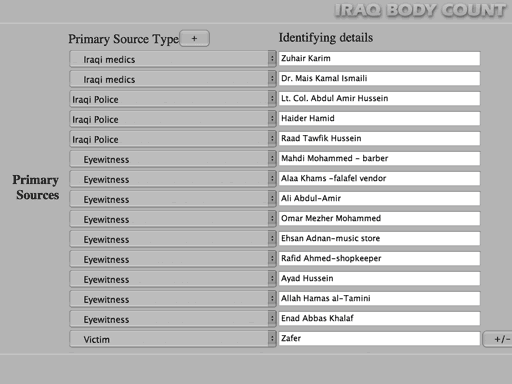In early 2006 IBC was invited to introduce its work at a Working Group Meeting on methods used by researchers to estimate armed conflict deaths (organised by the Small Arms Survey, Geneva, 17 Feb 2006).
Well-received by experts at the meeting, On Iraq Body Count summarised the project’s key features and innovations.
(Slide showing 15 primary sources for the incident: various medics, police, eyewitnesses, and survivor.)
2.3 Our sources and what we can extract from them (cont.)
Above is a screen shot of the part of our detailed database where all primary witnesses for incident k400 are listed.
-
This is confirmation that journalists are also active, not passive. They know their job, and in tracking down information on deaths will tend to use a variety of expert and official sources, eyewitnesses, etc. The common notion that reporters only record the deaths which they personally witness or which occur at locations where they are present bears no resemblance to their actual practice.
-
We also have an additional off-line database with a line for each individual victim, where we can record, where reported, name, age, gender and other demographic variables. We intend to progressively make more of the currently off-line searchable information available on-line for public use.
-
The principal on-line database is to be found at Iraqbodycount.org/database with a brief overview of the methodology and some key links. This contains date, time, place, target, weapon, reported numbers killed (minumum and maximum), and sources for each entry.
